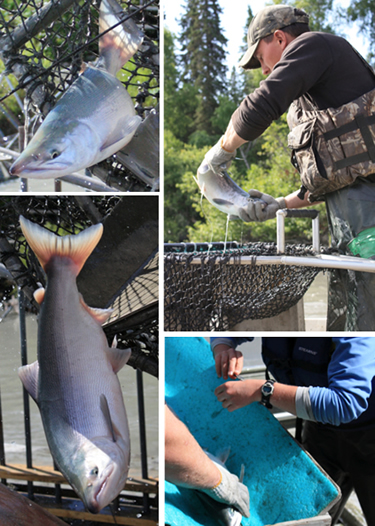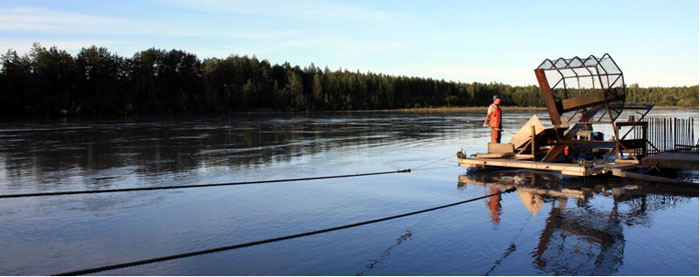
Yentna River
Other Tools
Other Tools

Estimating the abundance of a particular species of salmon in a river is easiest when they are not mixed with other fish species. Since sonar cannot identify fish by species, almost all Alaska Department of Fish and Game sonar sites use either gillnets or fish wheels to separate sonar-detected fish by species. At the Yentna River sonar site, ADF&G uses a fish wheel along each bank. Fish wheels capture fish by scooping them out of the river with large baskets and depositing them into a live box. The relative proportion of sockeye salmon to other species caught in the fish wheel is then examined to determine how many of the sonar-detected fish should be counted as sockeye salmon.
In 2008, ADF&G biologists determined Yentna fish wheels have a tendency to catch more pink salmon than what is representative of the species composition of fish migrations and particularly in years when large runs of pink salmon enter the river. Because pink salmon often return in very large numbers, the misclassification of even a small proportion of them can result in a substantial error in the sockeye estimate. The tendency of the fish wheels to catch a disproportionate number of pink salmon appears to be related to fish size. Pink salmon are the smallest of the Yentna River salmon species, and small fish have a greater tendency to swim close to the bank where fish wheels capture fish.
Mark-recapture studies and weir counts
In 2006, ADF&G biologists began a mark-recapture and weir study study to produce two independent estimates of sockeye salmon abundance for the Yentna River. None of these estimates is necessarily considered the correct number, but the closer the weir, mark-recapture and sonar site estimates come to agreeing, the more confident researchers become that they are getting close to the best possible estimate. As of 2011, researchers found that estimates produced based on the mark-recapture and weir projects were considerably higher than the estimates produced by the sonar project.
A fourth project was initiated in 2009 to estimate the species selectivity of the Yentna fish wheels. Fish are tagged at a site downstream of the Yentna sonar site. By keeping track of the number of each species tagged and then recaptured in Yentna site fish wheels, biologists hope to quantify the selectivity of the fish wheel for each species. If the fish wheel species selectivity can be quantified, then biologists might be able to formulate a correction they can apply to the fish wheel catch to produce more accurate sockeye estimates. Whether or not this can be achieved was still undetermined as of 2011.

